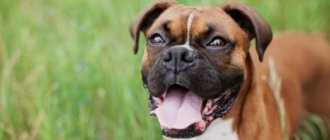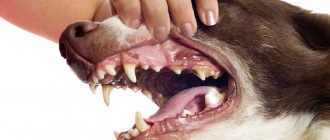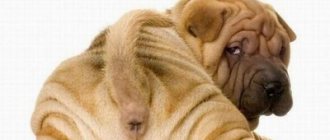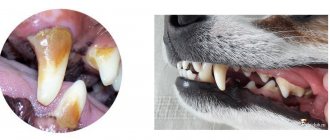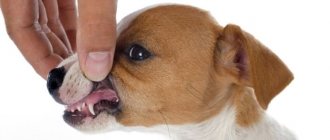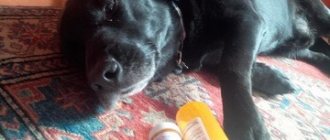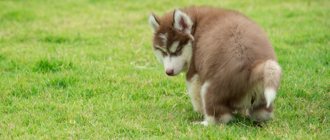A healthy and happy pet can bring a lot of joy to its owner. Therefore, a person is obliged to take care of those for whom he has taken responsibility.
The gastrointestinal tract plays an important role in the health of a pet. And it starts from the oral cavity.
Therefore, monitoring the cleanliness of teeth and the condition of the oral cavity is the direct task of a caring owner . Modern veterinary clinics offer ultrasonic teeth cleaning. This innovative method has already won many fans.
Indications for the procedure
The main indications for ultrasonic teeth cleaning are:
- unpleasant odor from the mouth of a tailed pet;
- plaque has already formed on the dog’s teeth;
- Tartar can be observed;
- appearance of mobile teeth.
These signs absolutely cannot be ignored. Germs in the mouth can lead to serious dental and gum disease.
Treatment will take a long time and will cost the owner much more than timely prevention.
Ultrasonic teeth cleaning and the health of your four-legged friend
Dental diseases in dogs, oddly enough, are similar to those of their owners. This is due to the fact that pets kept in apartments do not have the opportunity to chew on anything extra.
When a pet chews on a bone or stick, its teeth clean themselves, so to speak, without the use of a toothbrush. But if the dog does not have this opportunity, then caries, tartar and other “joys” come, even to the loss of teeth.
Small breed dogs most often suffer from dental diseases. Medium-sized pets are less likely to wear their teeth. And only about 45% of large dogs have such problems.
Owners whose pets have serious symptoms turn to veterinary hospitals:
- lost appetite;
- bleeding gums;
- lost teeth;
- bad odor from the mouth;
- deterioration of general condition.
But this could have easily been avoided if you examined your pet in time, received advice on proper feeding and knew the natural characteristics of your dog.
The most common problem with our furry friends is tartar. This is a formation that forms at the site of dental plaque. Usually these are phosphates together with carbonates and impurities of organic matter and microorganisms.
In turn, tartar turns into the cause of other diseases of the dog’s mouth cavity:
- caries;
- periodontal disease;
- periodontitis.
In fact, tartar cannot be considered a fatal disease, but when the phenomenon is neglected, there are secondary factors that are associated with the appearance of complications.
Chronic inflammatory processes in the gums and tooth loss begin. The dog refuses to eat, his gums swell and bleed.
In such conditions, raging bacteria stimulate intoxication of the body, often leading to blood poisoning. The situation could end extremely sadly.
Tartar removal
How often is it possible?
Few dogs are enthusiastic about brushing their teeth. The ultrasound procedure is performed much less frequently than the mechanical one. It is not used for prevention.
Tartar removed in a timely manner is an excellent opportunity to preserve your dog’s teeth into old age. Therefore, postponing a visit to the doctor is not recommended.
There are no specific indications regarding the frequency of the procedure. As soon as alarming symptoms become noticeable, you should immediately go to the veterinarian; usually cleaning is carried out 1-2 times a year.
Prevention of occurrence
Preventive measures are aimed at preventing the formation of tartar. The main measures in the fight against plaque are:
- Examination of the pet's oral cavity 1 to 4 times a month, depending on the size and age of the dog (in general, increased attention should be paid to the health of dogs over 5 years old).
- Timely cleansing of the tooth surface from soft deposits (at the stage of dental plaque).
- Use of bones in food (in pure form or as a treat).
The formation of dental plaque is a natural physiological process. During this time, cleaning procedures can significantly slow down the formation of tartar in dogs.
When is it better not to use anesthesia?
Many veterinarians offer to rid your dog of tartar under general anesthesia. This is due to the fact that during cleaning the pet experiences great discomfort. But do not confuse discomfort and pain . The dog does not experience pain during this cleaning. Therefore, by offering anesthesia to the dog, the veterinarian strives to make his work easier.
Doctors who practice ultrasonic teeth cleaning with anesthesia use general anesthesia. It has many contraindications and is a serious stress for the dog’s body. If the dog is not a large breed and calmly treats people in white coats, you can safely refuse general anesthesia . If the procedure may be painful, your veterinarian will offer local anesthesia.
Important! General anesthesia is necessary for owners of large breed dogs and aggressive animals that have recently experienced severe stress.
Is it possible to clean a dog’s teeth with ultrasound without anesthesia?
The possibility of high-quality teeth cleaning with an animal ultrasonic device (scaler) depends on many factors:
- the character and nervousness of the animal;
- the presence of hard or soft stone;
- the presence of inflamed, loose teeth, the touch of which causes pain;
- the need for tooth extraction.
Suturing when tooth roots are exposed
After ultrasonic cleaning and polishing of the dog's teeth.
Teeth cleaning, when performed by a specialist, is carried out both on the outside and on the inside surface of the teeth. An ultrasound machine is a buzzing machine. Ultrasound causes an increase in tissue temperature and a spray of water is applied to cool the tissue. If the animal is not familiar with this procedure, it begins to panic, bite, gnaw equipment, and if water gets into the throat, aspiration is possible, both with water and pieces of hard plaque flying off from the tooth with infection.
Therefore, even animals that regularly undergo dental cleanings require minor sedation (calming).
Preparation
Ultrasonic cleaning is a fairly serious and difficult procedure. It is impossible to do without preliminary preparation. The very process of influencing teeth with ultrasound can be difficult for a dog to tolerate , therefore, the owner and the veterinarian must work in a duet and do the maximum to ensure that the unpleasant procedure takes place without embarrassment and complications.
Worth it in advance:
- 8-12 hours before cleaning, do not give the animal food . Water can be offered without restrictions;
- Immediately before cleaning, an ultrasound of the heart and a biochemical blood test should be done . This measure should not be neglected if the administration of sedatives is planned.
How does ultrasonic cleansing occur without anesthesia?
After the owner has brought his pet to the clinic, he will be asked to undergo a series of tests and examinations . They are needed in order to understand whether the dog will need anesthesia.
Often diseased teeth need to be extracted, and the veterinarian must choose between local anesthesia and general anesthesia . Many specialists practice cleaning at home.
To clean teeth with ultrasound, a special device is used, it is called a scaler. It acts on problem areas in the animal's mouth with ultrasonic waves and does not cause pain to the dog. The device removes stones not only from the teeth, but also from under the gums. At the same time, the scaler does not damage the enamel .
The device is equipped with various attachments. By changing attachments, the veterinarian can remove plaque of any complexity, even in hard-to-reach places. The duration of the session is from 40 minutes to 1.5 hours.
After the ultrasonic cleaning is completed, the dog will undergo oral sanitation . This procedure is aimed at killing germs, disinfecting the mouth and slowing down the formation of tartar and plaque in the future.
Attention! If you compare the usual mechanical cleaning and ultrasonic cleaning, the mechanical one loses significantly. It is unlikely that a veterinarian will be able to thoroughly clean teeth completely of plaque, as a high-precision modern device will do.
Feedback from dog breeders and dog handlers regarding the new method is clear. The only exceptions are individual contraindications against the use of ultrasonic cleaning.
How to brush your dog's teeth at home
To maintain your dog's oral hygiene, you can visit veterinary clinics or grooming salons. But if the dog is accustomed to brushing its teeth, then it is not so difficult to do it on its own. At home, the dog will be calmer, and it will be more convenient for the owner to brush his teeth immediately after eating.
Considering that it is advisable to carry out the procedure daily or every other day, going to the clinic or salon with such frequency can become expensive.
Choosing a toothbrush for a dog
Toothbrushes for dogs should be purchased at pet stores and veterinary pharmacies.
The main criteria for choosing a toothbrush are the softness of the bristles and the appropriate size.
Many manufacturers indicate, based on softness and size, what type of breed a given model is suitable for.
Convenient toothbrush for dogs that fits on your finger. Photo: NB's Closet
Brushes for cleaning dog teeth are:
- in the form of a fingertip - soft silicone, put on the owner’s finger, with bristles on one or both sides. Suitable for cleaning the teeth of calm dogs with delicate gums.
- A brush with sponge bristles is suitable for sensitive gums, but does not provide thorough dental hygiene.
- with double bristles and a safety handle: at one end of the long handle there is a large brush, at the other - a small one. This model is suitable for cleaning both large back teeth and smaller front teeth.
- with three bristles: designed for thorough dental hygiene on all sides, suitable for cleaning the teeth of large breed dogs.
- disposable brushes - have soft bristles and are coated with toothpaste. Easy to use - the brushes can be disposed of after use, but the cleaning process becomes somewhat costly.
- treat brushes: both in the form of “bristles” and in the form of seeds.
Which pasta to choose
Toothpaste is essential when brushing; it helps remove plaque, freshen breath, and keep teeth white and healthy.
The main thing in paste is safety, because some part of the paste will inevitably be swallowed by the animal, and this should not harm your pet.
By using special toothpaste for dogs, you don't have to worry if your pet swallows it during the cleaning process.
Different toothbrushes for dogs
Pastes have different tastes and smells: the taste of meat (for example, chicken or beef), with the smell of mint or vanilla.
The main “signs” of a good toothpaste for a dog: thick, white, does not foam, does not require rinsing after brushing the teeth.
Natural plant components, extracts of sage, eucalyptus, tea tree, etc. are added to many pastes. These supplements have a mild healing effect and will be beneficial for the gums.
Toothpaste for dogs from 8in1
Popular brands of toothpaste manufacturers:
- Api-san (Russia),
- Beaphar (Netherlands),
- Hartz (USA),
- 8 in 1 (USA),
- Gimpet (Germany),
- Trixie (Germany),
- Camon (Italy).
These brands have been on the market for decades and have established themselves as leaders in specialty pet oral care products.
Choosing a toothpaste is an individual process and should be taken seriously.
Buy pastes only from veterinary stores or pharmacies.
After the first cleaning, you should check the animal for allergic reactions: any itching or redness on the lips, mouth, swelling on the face. If such symptoms appear, the animal should be shown to a veterinarian, and this paste should be discarded.
How else can you brush your dog's teeth?
Sometimes it is not possible to use veterinary brushes and toothpastes to clean teeth. In this case, you can use suitable alternative remedies.
Gauze swab
If you cannot use a dog toothbrush, you can use a gauze swab wrapped around your finger. This option is not suitable for constant use; a bandage will not be able to remove small particles of food between the teeth or reach hard-to-reach places, and this method is also not always safe. But for emergency cases, if you don’t have a toothbrush at hand, the method can be considered suitable.
Toothbrushes and powders for infants
If it is not possible to purchase a special toothbrush, then you can use toothbrushes designed for children over 6 months. Their bristles are soft, and there is also a model in the form of a fingertip.
It is better to use a special toothbrush. Photo: Teeth Cleaning
As a substitute for toothpaste, you can use tooth powder for the youngest children. Carefully study the composition of the powder: it should not contain fragrances and flavoring additives, as well as fluorine. When used, such a powder should not foam. But you shouldn’t abuse it often either.
Other veterinary oral hygiene products
An alternative to brushing and toothpaste is using veterinary gels, lotions and oral hygiene sprays.
Teeth cleaning gels
They are applied to the teeth and gums after meals; there is no need to use a toothbrush.
Teeth cleaning gel from Api-San
Some gels contain the drug metronidazole, which fights germs on the teeth and relieves inflammation of the gums. The gel with this drug is effective for bleeding, redness, increased sensitivity of the gums and oral mucosa.
Dental lotions and sprays
Just like gels, lotions are applied directly to the teeth after eating, and dental sprays for dogs are sprayed into the open mouth.
Liquids and tablets “for cleaning teeth”
These are special additives that are given to the animal with food. And the drug in the form of a tablet is glued to the gums after eating.
Using only these means, it will not be possible to achieve 100% success in the fight against plaque and tartar, as well as bad breath. Unfortunately, all these remedies only mask bad breath and are not able to definitely prevent caries, since they do not fight the cause - food debris on the teeth.
Only mechanical brushing of teeth using toothpastes can remove food debris and visible plaque on teeth.
Gels, lotions or treats can be used if the dog categorically refuses to brush its teeth and such hygiene is the only solution to the problem of dental care.
Treats for cleaning teeth
A good “backup option” is to use treats to clean your teeth. The shape and structure of the treat mechanically helps clean teeth and prevent the early appearance of caries.
Photo: Christopher
Treats are also selected based on the size of the dog.
Photo
Check out the photos below of ultrasonic teeth cleaning without anesthesia:
How long does the result last?
Ultrasonic cleaning is not a cheap procedure. It requires not only money, but also nerves . It’s rare that a dog calmly tolerates foreign, buzzing objects in its mouth. And it’s unpleasant for the owner to watch his pet being “tormented”.
There is good news for dog owners. Ultrasonic cleaning is recommended to be carried out no more than 2 times a year. If necessary, the number of procedures can be reduced to once. If the owner independently monitors the condition of his pet’s oral cavity, the results after cleaning will last much longer.
What not to brush your dog's teeth
It is not advisable to use a human toothbrush: it has bristles that are hard on the animal’s gums, and the size is not suitable for every dog.
Our regular toothpastes are also not suitable for dogs. And it's not just the sharp taste and strong smell. Conventional toothpastes contain large amounts of fluoride, which, if swallowed by an animal, causes metabolic disorders and even poisoning of the body.
But baby toothpastes without fluoride cannot be used either. All pastes for humans contain a sweetener, which can cause seizures and heart problems in dogs.
